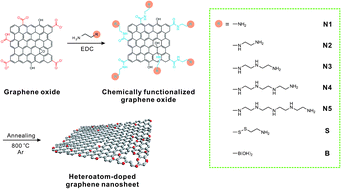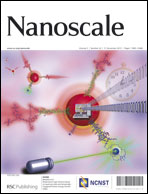Covalent functionalization based heteroatom doped graphene nanosheet as a metal-free electrocatalyst for oxygen reduction reaction†
Abstract
Oxygen reduction reaction (ORR) is an important reaction in energy conversion systems such as fuel cells and metal–air batteries. Carbon nanomaterials doped with heteroatoms are highly attractive materials for use as electrocatalysts by virtue of their excellent electrocatalytic activity, high conductivity, and large surface area. This study reports the synthesis of highly efficient electrocatalysts based on heteroatom-doped graphene nanosheets prepared through covalent functionalization using various small organic molecules and a subsequent thermal treatment. A series of nitrogen-doped reduced graphene oxide (NRGOn) nanosheets exhibited varying degrees and configurations of nitrogen atoms within the graphitic framework depending on the type of precursors used. On the basis of the rotating disk electrode (RDE) and rotating ring–disk electrode (RRDE) experiments, NRGO3, with a high degree of pyridinic-N content, displayed the desired one-step, quasi-four-electron transfer pathway during ORR, similar to commercial Pt/C. We also demonstrated the potential of covalent functionalization of sulfur and boron-doped graphene nanosheets.


 Please wait while we load your content...
Please wait while we load your content...